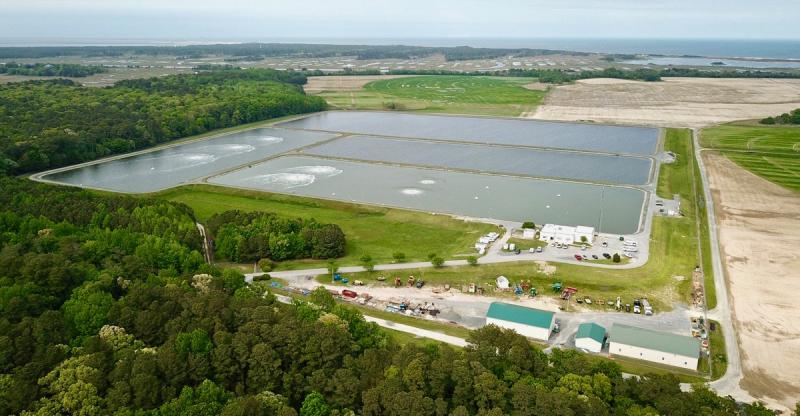Major Sussex sewer projects aim to reduce pollution
Over the next few years, Sussex County has an ambitious schedule of sewer projects that will remove the equivalent of 1,900 septic tanks in the Inland Bays area, where most of the county's customers are.
The county has 75,330 sewer and water accounts and issued 1,945 permits for sewer connections last fiscal year.
The county has budgeted more than $34 million in fiscal year 2020 and $200 million over the next three years for sewer projects.
“We are driving the health of the Inland Bays,” said Sussex County engineer Hans Medlarz. “Our rate payers carry the burden of Inland Bays clean up.”
Multi-year projects totaling $116 million are also underway at the county's three wastewater treatment plants.
Sussex County's work to expand and improve its wastewater treatment system is an essential part of the Comprehensive Conservation and Management Plan for the Inland Bays, said Chris Bason, Delaware Center for the Inland Bays executive director.
“Over the years, the county has done an outstanding job converting septic systems to centralized treatment systems, thereby greatly reducing the amount of nutrient pollution entering the bays,” Bason said. “The county values creativity and collaboration in its approach that has resulted in affordable services to its customers and restoration of important wildlife habitat.”
Medlarz was among other county department heads who made presentations during a May 7 Sussex County Council workshop as officials and staff aim toward approving the 2020 fiscal budget before a June 30 deadline.
The proposed $185.7 million county budget is broken down as follows: $81 million, general fund; $21 million, general fund capital projects; $34.6 million, water and sewer capital projects; and $7.5 million, pension fund.
Two large sewer projects are underway simultaneously with anticipated completion in three years. The $21 million Herring Creek project includes more than 700 units, and the $5 million Chapel Branch project includes more than 400 units. The county recently completed the Angola North district project with more than 250 units.
Once online, Medlarz said, the Herring Creek project alone will remove more pounds of nitrogen and phosphorus daily from the Inland Bays than the entire City of Rehoboth Beach discharged prior to the ocean outfall project.
Work at Wolfe Neck plant
The county has embarked on a five-year, $14 million project to convert the Wolfe Neck treatment plant near Rehoboth Beach to a fixed-head grid system to spray treated wastewater on a wooded area. The plant currently uses the more traditional pivot-irrigation rig system to spray treated wastewater on farm fields.
The county leases the property – located adjacent to Cape Henlopen State Park – from the state.
Included in the agreement with the state iare a partnership with the Delaware Center for the Inland Bays to plant trees on the property; a $1 million contribution to the Delaware Division of Parks for a new trail around the perimeter of the property, linked to Cape Henlopen State Park; a University of Delaware research project to study groundwater nutrients; and a deer-hunting agreement with the Division of Parks.
“When we look back on this 10 years from now, it will be a flagship agreement,” said Sussex County Administrator Todd Lawson.
Medlarz said the first step, signing a 25-year lease with the Delaware Department of Natural Resources and Environmental Control and the Division of Parks, has been completed, and a site plan is being developed.
In addition, the county has signed an agreement with the City of Lewes Board of Public Works to divert wastewater flow from the Wolfe Neck plant to the Lewes treatment plant. Medlarz said about 200,000 gallons are flowing to Lewes on a daily basis. The work will maintain capacity at the plant around 2 million gallons per day.
Upgrades in Rehoboth Beach
According to an agreement signed with the City of Rehoboth Beach in 2017, Sussex County will have more say in future phases to upgrade the city's treatment facility and collection system.
The cost of Phase 2 of the project, which includes $6 million in electrical upgrades to the Rehoboth treatment facility, is being split in half, with the county providing zero percent financing for $3 million to Rehoboth to be paid back within 10 years.
Medlarz said Phase 3 of the project is not funded. He said it will be up to Rehoboth Beach officials and residents to decide on the fate of Phase 3, estimated to cost $18 million to $20 million.
Proposed work includes upgrades to increase flow capacity beyond 3 million gallons per day, building and site upgrades, and various other equipment upgrades and replacements.
“We can only react after Rehoboth pins down the Phase 3 scope of work,” he said. “We are part of the discussion, but we don't make the final decision.”
Work at county's plants
Work is underway at the Inland Bays treatment plant to construct regional septage and biosolids facilities to serve all of Sussex County. The $14 million facility would treat septage hauled to the site by private haulers and municipalities and turn it into biosolids that could be used as fertilizer by area farmers. Work is expected to be completed by early 2020.
“The real test will be if farmers want it, or will we have to pay to get rid of it?” Lawson said.
An incentive program for farmers to use the material could be developed, Medlarz said.
In addition, multi-year projects are underway to upgrade and expand capacity at the county's Inland Bays and South Coastal treatment facilities. The $40 million Inland Bays project will increase capacity from 2 million gallons per day to 5 million gallons per day. The $48 million South Coastal project will expand capacity from 6 million gallons per day to 10 million gallons per day.
Medlarz said the work will provide enough capacity for the next 15 to 20 years.
Current capacity Future capacity
Wolfe Neck 2.0 mgd 1.5 mgd
Inland Bays 1.5 mgd 5 mgd
South Coastal 6 mgd 10 mgd
mgd = million gallons per day
























































